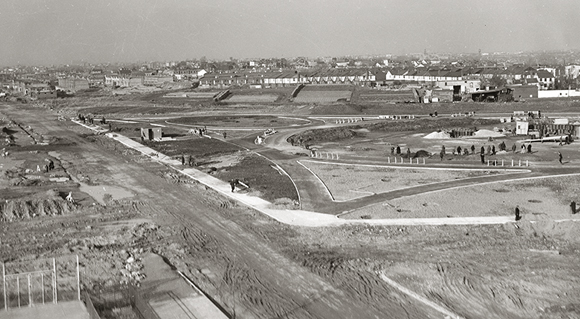In 1934, only 4 in 10 Americans were homeowners. When Congress created the Federal Housing Administration to provide mortgage insurance on loans made by FHA-approved lenders, it opened up a world of opportunity for those wishing to buy a home and led to a building boom. This had come not a moment too soon as the country was in the midst of the Great Depression and 2 million construction workers were unemployed.
The population of Middle Village grew rapidly in the years leading up to WWII, and with promises of a new park and quick trolley rides to the Woodhaven Blvd station of the 8th Avenue subway line, one area they wanted to settle in was Juniper Valley.
Penelope Homes
In 1937, the Penelope Homes development began. This was an enclave of 15 homes fronting Penelope Ave between Dry Harbor Road and 82nd Place. Each house contained 6 rooms, with a rear open porch, recreation room, breakfast nook, and bar. Made of stone and brick, they also featured oil burners and heated garages. They were sold for less than $7,000 apiece.
Juniper Park Homes
By far, the largest development of the era was the Juniper Park Homes. It took a while for the land for this undertaking to be assembled because it was an “all-or-nothing” proposition. The land was divided up amongst German farming families and the tracts cut diagonally across city streets. Unless the whole thing was acquired, it would leave triangles of unused space. But Stewart Wiley and his partners managed to get it done and began construction on the coveted land in 1937. Juniper Park Homes consisted of 1500 houses and the developers promised that prices would be “at a market level that will rival rents to be charged at public housing projects.” The homes featured “symphonic styling” and sunken living rooms. The community was centered at 79th Street and Eliot Avenue. Three types of housing styles were offered ranging in price from $4,500 to $6,490. The “Residents of Juniper Park Homes” civic organization, created in 1938, was the progenitor of the Juniper Park Civic Association.
Superb Homes
Eliot Avenue and 80th Street was the center of the Superb Homes tract, built in 1938. There were 152 dwellings in this project, which spanned 2 blocks.
Mayflower Homes
Also in 1938, the Mayflower Homes started at 84th Street and 61st Road and were expected to number 195 houses. They were described as “solid brick, two-story Colonial homes with white doorways and brass fixtures” and were built in 2 styles. They were priced at $5,590.
Green Park Homes
In the same vicinity were William Noone and John Turner’s Green Park Homes. These homes featured sun decks and oversize steel casement windows as well as colorful tile baths and scientific kitchens. They marketed their homes as “luxury for the working man.” The last available home out of 100 was sold in 1939. Based on word of their success, the developers were invited to Cuba to build a resort there, but declined and passed the offer on to an associate of theirs.
Tru Homes
Eliot Avenue and 81st Street was the location of the Tru Homes. There were 125 two-story homes and 60 one-story homes in this colonial-style development. They were in move-in condition by 1939. The The Tru Homes emphasis was on kitchen efficiency in order to lessen the daily household burden on the housewife. Prices started at $5,200.
In 1941, Norman K. Winston took over as the president of Juniper Park Homes and announced that construction of 100 more dwellings would commence on two blocks in the vicinity of 77th Street and Eliot Avenue. Residential building slowed down across the country during WWII as demand shifted to defense construction and prospective mortgage payers were sent overseas to fight. But the end of the war brought about a third building boom, and this will be examined in the next edition of the Juniper Berry.




